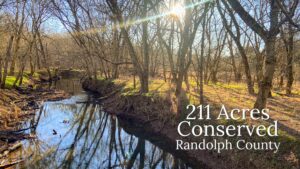
by Crystal Cockman
April 13, 2016
 Last week I took my first float trip of the season, down the Uwharrie River from Highway 109 to Hidden Lake. There’s a new access at Highway 109 now with a canoe slide and steps down to the river, thanks to the NC Wildlife Resources Commission (WRC). The land we took out on is owned by The LandTrust for Central NC, but soon there will be a more formal take-out on WRC land off Dennis Road.
Last week I took my first float trip of the season, down the Uwharrie River from Highway 109 to Hidden Lake. There’s a new access at Highway 109 now with a canoe slide and steps down to the river, thanks to the NC Wildlife Resources Commission (WRC). The land we took out on is owned by The LandTrust for Central NC, but soon there will be a more formal take-out on WRC land off Dennis Road.
This is one of the prettiest stretches of the Uwharrie River, and the first place I ever saw a bald eagle in the wild back in 2005. On this river trip, we chased a bald eagle down river for quite a while – he would light on a tree until we got close, then fly downstream a bit and light again, repeating the scenario every time we got close. But in addition to this great big bird, we got to hear a variety of the early spring migratory birds that have already begun to call in our woodlands.
One bird we heard who has a distinctive call is the Northern parula (Setophaga americana). This small warbler has a blue head and wings and a bright yellow neck and chest. The song sounds like a trill increasing in pitch followed by a quick dip, a build up with a falling off at the end. They prefer to nest in Spanish moss or other epiphytes, but will also nest where there are dangling clumps of twigs or branches. They are believed to be mainly monogamous, and will oftentimes come back to nest in the same spot year after year.
Another spring migrant we heard clearly and loudly from the forest canopy was the Louisiana waterthrush (Parkesia motacilla). It is a type of warbler as well, but looks more like a thrush or sparrow in coloration, with brown wings and a brown and white striped chest. The early part of their call is a series of descending notes, and to me the end part of their call sounds like a seesaw, varying back and forth in pitch. They breed in eastern North America and prefer areas along creeks and rivers. They spend the winter in Central America and the West Indies, and are one of the earliest birds to return back to their breeding grounds in the springtime.
A third species we were able to hear on our river trip was the Hooded warbler (Setophaga citrine). This small bright yellow bird has a black neck and hood. Their call is also easy to distinguish, and sounds like wheeta-wheeta-wheet-e-o. They typically nest in small bushes near the ground, and are easily parasitized by brown-headed cowbirds. They feed on a variety of insects, some of which are caught in midair.
Another common occurrence on this trip was scaring up wood ducks, who quickly flapped away down river. Near the conclusion of our trip, where the river begins to open up wide and flow becomes slower, we had yet another bird encounter. A large osprey was spotted above us, and he even had a fish in his talons. This was a nice way to round out our float trip/birding adventure. Next time you go kayaking or canoeing, see how many different species of bird you can hear and spot along the way.